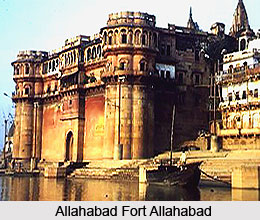 Allahabad is one of the holy cities of Hinduism which was formerly known as Prayag in Uttar Pradesh. It is beautifully located at the confluence of the Ganga River, Yamuna River and the Saraswati River and is one of the largest cities of the Indian subcontinent. The confluence is known as Triveni Sangam. It is one of four locations of the Kumbha Mela, an important accumulation Hindu pilgrimage.
Allahabad is one of the holy cities of Hinduism which was formerly known as Prayag in Uttar Pradesh. It is beautifully located at the confluence of the Ganga River, Yamuna River and the Saraswati River and is one of the largest cities of the Indian subcontinent. The confluence is known as Triveni Sangam. It is one of four locations of the Kumbha Mela, an important accumulation Hindu pilgrimage.
History of Allahabad can be broadly classified into three main periods. They are ancient time, the medieval and the modern time.
Ancient History of Allahabad
The city of Allahabad was popularly known as Prayaga as it is believed to be the spot where Lord Brahma offered his first sacrifice after creating the world. The name of Allahabad is also referred in the Vedas. In the Puranas it is mentioned that King Yayati went from Allahabad and conquered the region of Sapta Sindhu. Allahabad seemed to be the important territory of the Aryans.
Ramayana also describes Allahabad as being made up of a number of huts of a few rishis at the confluence of the sacred rivers. It is considered that Lord Rama spent some times in the ashram of Bharadwaja before going on to Chitrakoot.
Allahabad was a part of the Maurya Empire and Gupta Empire of the east and the Kushan Empire of the west. After that it became a part of the Kannauj Empire. The Chinese chronicler Huien Tsang wrote that he visited Allahabad in A.D. 643.
Medieval History of Allahabad
Allahabad was a part of the Delhi Sultanate after the town was occupied by Muhammad Ghori in 1193. In the year 1526 Allahabad became a part of the Mughal Dynasty. Mughal emperor Akbar built a splendid fort on the banks of the holy confluence for its strategic position in the Doab region. Akbar renamed the city as Illahabad in 1575. The magnificent fort that was built by Akbar has an Ashokan pillar and some temples, and was largely a military barracks. Jahangir, son of Akbar, directed a revolt against his father from the city of Allahabad.
 Allahabad was rocked by Marathas before the colonial rule took over the charge. But the Marathas also left behind two splendid eighteenth century shrines with convoluted structural design.
Allahabad was rocked by Marathas before the colonial rule took over the charge. But the Marathas also left behind two splendid eighteenth century shrines with convoluted structural design.
Modern History of Allahabad
In the year 1765 the British defeated the combined forces of the Nawab of Awadh and the Mughal emperor Shah Alam II. Then the British rulers established a battalion at Fort Allahabad, understanding its tactical location as it was gateway to the northwest. Later Governor General Warren Hastings took the charge of the city and offered it to Awadh, claiming himself in the power of the Marathas. In the year 1801 the Nawab of Awadh yielded the city to the British East India Company.
Allahabad became the seat of the Government of Agra Province in the year 1834. Allahabad was active during 1857 when the Sepoy Mutiny was running. During the Mutiny, Allahabad had only a small garrison of European groups. Maulvi Liaquat Ali, one of the prominent leaders of the revolt, was a native of the village of Mahgaon near Allahabad. The British established the High Court, the Police Headquarters and the Public Service Commission in the city after the Mutiny was over. This transformed Allahabad into an administrative centre.
In 1877 the two provinces of Agra and Awadh were amalgamated to form a new state which was called the United Provinces of Agra and Oudh. Allahabad was chosen as the capital of this new state and remained till the 1920s.
The Indian National Congress organised its fourth and eighth session in the city in the years 1888 and 1892 respectively on the extensive grounds of Darbhanga Castle, Allahabad. Anand Bhavan and Swaraj Bhavan in Allahabad were the centres of the political activities of the Indian National Congress. The first Prime Minister of India, Jawaharlal Nehru and several Union ministers such as Mangla Prasad, Muzaffar Hasan, K. N. Katju, and Lal Bahadur Shastri, were inhabitants of Allahabad.
Allahabad was a well known centre of education in the past and till now the city has immense importance.
Literary History of Allahabad
Allahabad city has a literary past also. Many famous Urdu and Hindi authors like Munshi Premchand, Mahadevi Varma, Sumitranandan Pant, Suryakant Tripathi `Nirala`, Subhadra Kumari Chauhan, Upendra Nath Ashk and Harivanshrai Bachchan were connected to the city. Short story writers Azam Kuraivi, Ibn-e-Safi, and Adil Rasheed are all from Allahabad.
The publishing firm Kitabistan, owned by the Rehman brothers, Kaleemur Rehman and Obaidur Rehman was another landmark in the literary history of Allahabad. It is believed that famous English author and Nobel Laureate (1907) Rudyard Kipling spent time at Allahabad while working for The Pioneer.



















